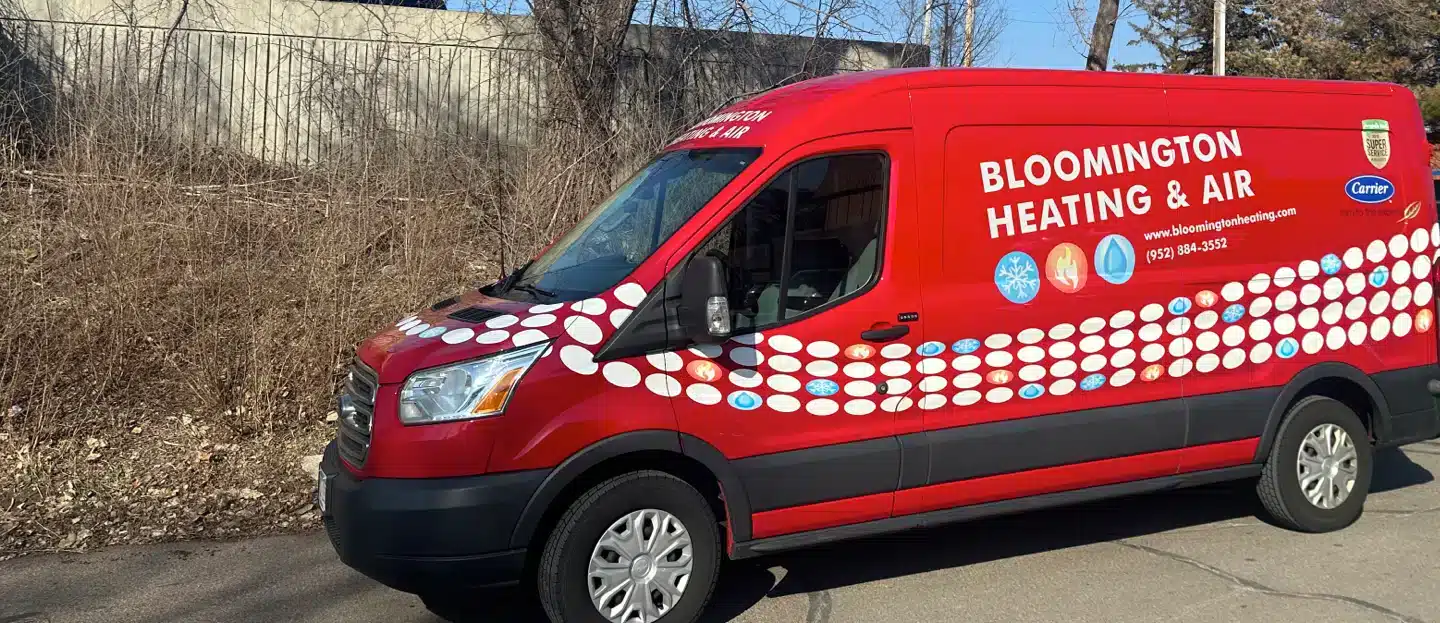
24/7 Emergency Phone Line
Family Owned & Operated
Licensed, Bonded & Insured
Everyone breathes indoor air but not necessarily the same air quality. Unless you’re monitoring your indoor air quality (IAQ), pollutants could be affecting your health and comfort more than you realize. The trick to improving IAQ is having a well-sealed home with ample air recirculation and filtration. Here are the products, services, and do-it-yourself techniques Bloomington Heating & Air recommends for creating clean air at home all year.
Clean The Home Regularly With Natural, VOC-Free Products
Cleaning your home regularly is critical to trapping dust, pollen, pet hair, and other enemies of air quality. However, the very products you’re using to remove pollutants could be contributing new ones, lowering your indoor air quality as you clean. The American Lung Association reports that some household cleaners — aerosol spray products, air fresheners, chlorine bleach, detergents, and dishwashing liquids, rug and upholstery cleaners, furniture and floor polishes, and oven cleaners — contain hazardous chemicals known as volatile organic compounds (VOCs). In addition to the negative environmental impacts of VOCs, they can also create dangerous fumes that cycle through the HVAC system, which can lead to respiratory issues. Even purportedly “green” products are not necessarily safer.

So, what’s the alternative? In most cases, a simple mixture of soap and water on a microfiber cloth or mop has sufficient cleaning power to eliminate dirt, grime, and most pollutants from hard floors and surfaces. For tougher, baked-on grease or embedded grime, try scrubbing with baking soda and water. Applying a mixture of water and vinegar produces sparkling, streak-free glass surfaces. Fabrics attract more debris than hard surfaces. Vacuum the carpets, curtains, and cloth furniture weekly using a vacuum with rotating brushes and a HEPA filter, which traps smaller particles. When washing bedding and clothing, use hot water (above 130 degrees Fahrenheit) on fabrics that can handle it to kill bed bugs, dust mites, and other health risks.
Take Preventative Measures To Keep Out Pollutants & Monitor IAQ
In addition to cleaning, there are proactive measures you can take to stop chemicals, dust particles, and allergens from settling in the home in the first place. Outside of every entrance to the home, lay down a floor mat that has firm bristles. And when visitors come inside, request that they remove their shoes. The Environmental Protection Agency (EPA) has a list of common sources of indoor air pollution, and one of the most dangerous ones is lead. Surprisingly, lead can be tracked into homes in the dirt on the bottoms of shoes. Some risks to air quality are generated from inside of the home. If you plan to remodel or paint, for example, turn on a fan and open the nearest window to whisk dust or fumes outside. Every once in a while, opening the windows around the home to let new air circulate can help freshen the air. But remember to turn off the air conditioner first, so you don’t waste electricity. And if it’s allergy or fire season, it’s probably better to keep the home sealed until the outdoor air quality improves.
Tobacco and vape smoke also affect indoor air quality. If members of your household smoke, politely ask them to do so outside at least several paces from the property. But whether or not you have smokers in the house, one way to ward off bad odors and the chemical pollutants that cause them is to introduce houseplants. While plants eliminate carbon dioxide humans breathe out, some plants — such as aloe vera, chrysanthemum, and English ivy — can filter out other indoor pollutants. Monitoring IAQ with a carbon monoxide detector or a device that measures humidity can help you address air quality concerns. It’s also worthwhile to monitor the local air quality conditions measured by the Minnesota Pollution Control Agency. If the outdoor air quality is low, avoid opening the doors and windows and seal them with weather-stripping.
Recirculate & Filter Indoor Air With A Whole House Air Purifier
In order to truly achieve high indoor air quality, you have to do more than remove particles from the ground by cleaning; you must also pull them out of the air through recirculation and filtration. But, with so many air cleaning devices available on the market, it can be a challenge knowing which air purifier is right for you, let alone where to buy it or who to have install it. Our HVAC company in Bloomington, MN, specializes in IAQ services and products, and we have a few recommendations on this subject.At some point, you’ve probably seen air purifiers, humidifiers, and other IAQ products offered in stores. While these portable systems sell well, they usually fall short of fulfilling the buyer’s intended goal. Every air purifier has a maximum square footage rating that indicates how large of a space it can handle. A portable unit may improve the air quality in a single room, but it would leave the rest of the home unprotected.A better solution is a whole house air purifier. This type of purifier connects to the central heating and cooling system and filters the air evenly across every room that the ductwork reaches.
To avoid wasting money on a system that’s either underpowered or has more capacity than the home requires, let an HVAC technician suggest air purifier models that fit your needs. After the air purifier has been installed, it should be maintained regularly by a professional technician. This both ensures the purifier functions at full capacity and prevents future repairs. Additionally, air purifier maintenance can be combined with heating and cooling maintenance, which itself can improve IAQ by replacing dirty HVAC filters or removing dust, mold spores, and pest debris from air ducts. Every day is the right time to focus on having clean, healthy air.
Whether you’re constructing a new house or looking to improve the air quality where you live, Bloomington Heating & Air sells and installs residential IAQ systems to fit all homes. Contact us to schedule air quality services in Bloomington, MN!
